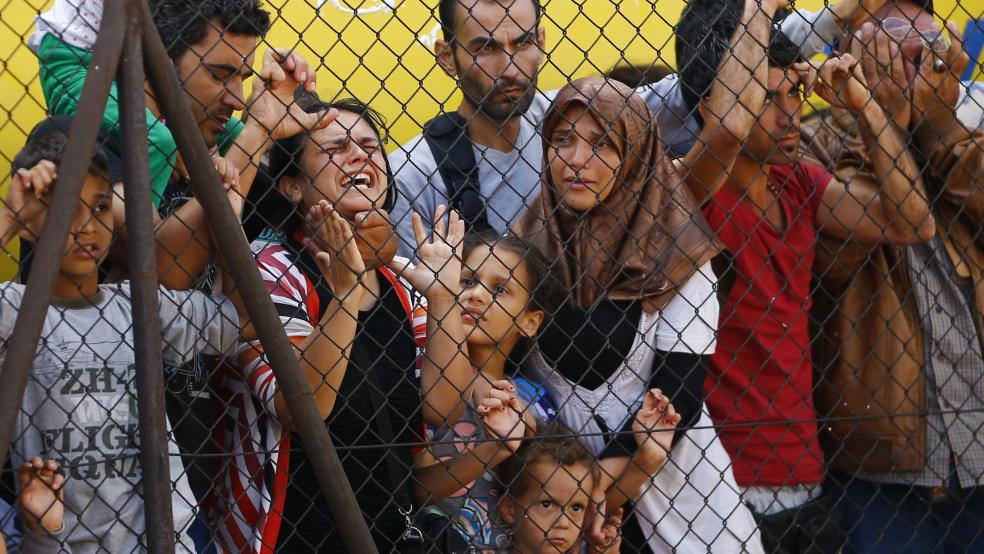Donald Trump’s latest proposals for preventing “radical Islamic terrorists” from entering the country by temporarily barring immigrants from “the most dangerous and volatile regions” of the world and engaging in “extreme vetting” of immigrants’ ideological beliefs could profoundly alter the religious makeup of refugees and others allowed to enter the U.S. in the future.
The Republican presidential nominee and his advisers have provided few details of the potential impact of their latest proposal for choking off the flow of refugees and immigrants from Syria, Iraq, North Africa and other terrorism hot spots.
Related: Trump Promises to Get ‘Vicious’ With Radical Islam
However, the Pew Research Center reported this week that nearly half of the more than 63,000 refugees who have entered the country so far in the current fiscal year are Muslims. Experts say that number would likely be slashed dramatically if Trump were suddenly in charge of the country’s immigration policies.
Using data from the State Department’s Refuge Processing Center, the Pew researchers found that the U.S. has accepted 28,957 Muslim refugees so far since last October, or 46 percent of the total. That means that already this year, “the U.S. has admitted the highest number of Muslim refugees of any years since 2002,” when data on self-reported religious affiliations first became available, according to the report.
The Obama administration set a ceiling of 85,000 on the number of refugees who will be allowed into the country this fiscal year, meaning there is room for 22,000 more before the deadline Sept. 30. Even that number is considered paltry compared to the magnitude of the problems of more than 10 million refugees displaced by the civil war in Syria alone.
As of earlier this month, the countries of origin for the majority of these refugees entering the United States included Myanmar (10,464), the Democratic Republic of the Congo (10,417), Syria (8,569) and Iraq (7,479). Taken together, these four countries represent 58 percent of all refugees allowed to enter the U.S. this year.
Related: The Russian Government Could Be Manipulating the US Election
Christians made up the second-largest group of refugees, with 27,556 entering the country. In the past, Christian refugees slightly outnumbered Muslims, but that began to change in fiscal 2006, when large numbers of Somali refugees flocked to the U.S., according to Pew.
Yet refugees constitute only about a tenth of the roughly one million immigrants granted lawful permanent residency in the United States every year. And that doesn’t include the millions of others who annually enter the country on temporary H-1B work visas and student visas, or simply enter as tourists.
While it’s impossible to say with certainty the percentage of total immigrants who are Muslim, a 2013 report by the Pew Center roughly pegged that number at 10 percent.
Experts say that Trump’s latest proposals for vetting immigrants, visitors and refugees to root out possible terrorists could force profound changes in immigration patterns for years to come.
Related: As Young Voters Flee Trump, Republicans May Be Losing a Generation
“I don’t know what ‘extreme vetting’ is,” Marie Price, a professor of geography and International Affairs at George Washington University, said in an interview Wednesday. “But it could have significant impacts well beyond the refugee population, which is very, very small.”

“The refugee flows are an important obligation we have in holding up the principles of refugee resettlement,” she said. “
Michael O’Hanlon, a foreign policy expert with the Brookings Institution, said that without congressional support, there are limits to what Trump could do as president by executive fiat to slam the door on Muslims seeking to enter the country – if he is truly serious about it.
“Does he realize he’s overplayed his hand, and look for a symbolic way to toughen up what is, I think, already a fairly vigorous and rigorous screening/interview process?” O’Hanlon said in an email. “Or does he try to make the process so onerous that one essentially has to prove one’s innocence beyond a shadow of a doubt, and thereby really clamp down on the numbers? I don’t think we really know.”
Related: Here’s What Happens If Trump Decides to Quit
“With Trump, at this point, I’m inclined to believe the more extreme interpretation, but I don’t think we can be sure until he tells us what ‘extreme vetting’ actually consists of—and even then, it may not be clear,” O’Hanlon said in an email Wednesday.
Trump, who is trailing Democratic presidential nominee Hillary Clinton in the polls, outlined his view on Monday during a national security speech at Youngstown State University in Ohio. Since calling for a temporary ban on most Muslims from entering the country until the U.S. gets a better handle on domestic terrorism, Trump has been under pressure to better define what he has in mind. And many in his own party, including House Speaker Paul Ryan of Wisconsin, have objected to his more draconian proposals for excluding Muslims.
“Just as we won the Cold War, in part by exposing the evils of communism and the virtues of free markets, so too must we take on the ideology of radical Islam,” Trump said.
Trump has promised as president to impose a vigorous – even “extreme” – process for vetting of refugees and immigrants attempting to enter the country to cut down on the possibility of Muslim immigrants or their children.
Related: Warren Buffett Scolds Donald Trump: Have You No Sense of Decency, Sir?
“The common thread linking the major Islamic terrorist attacks that have recently occurred on our soil – 9/11, the Ft. Hood shooting, the Boston Bombing, the San Bernardino attack, the Orlando attack – is that they have involved immigrants or the children of immigrants,” Trump said in his Ohio speech. “Clearly, new screening procedures are needed.”





